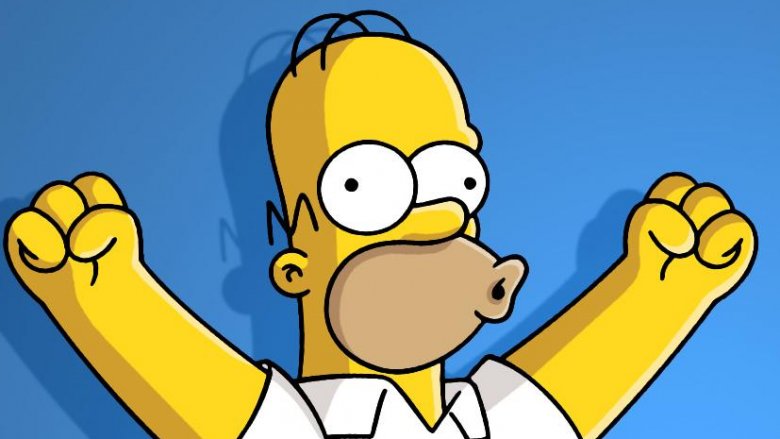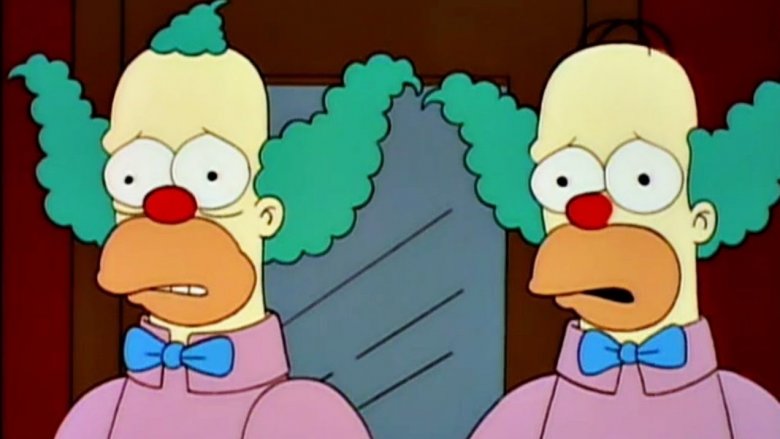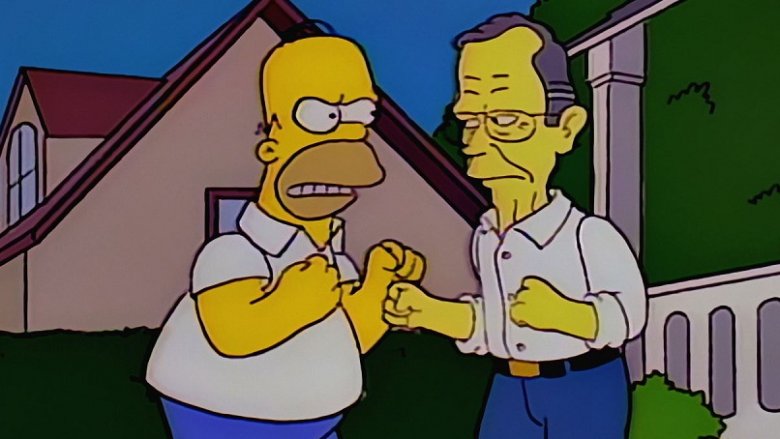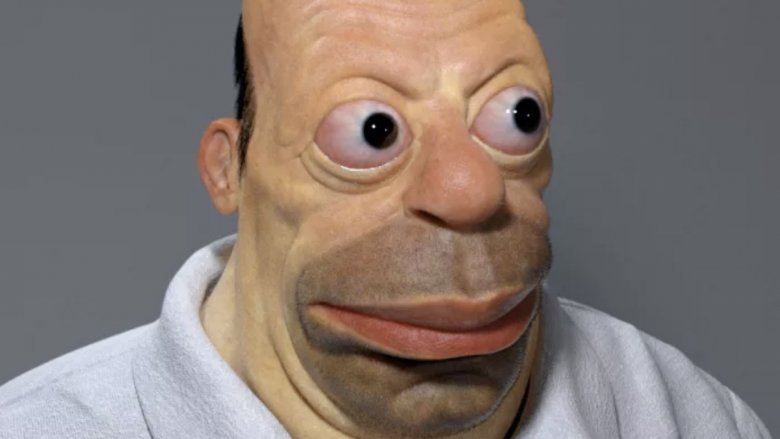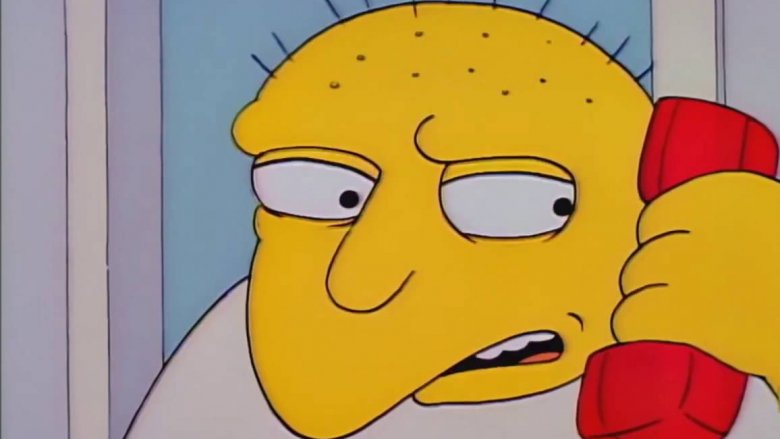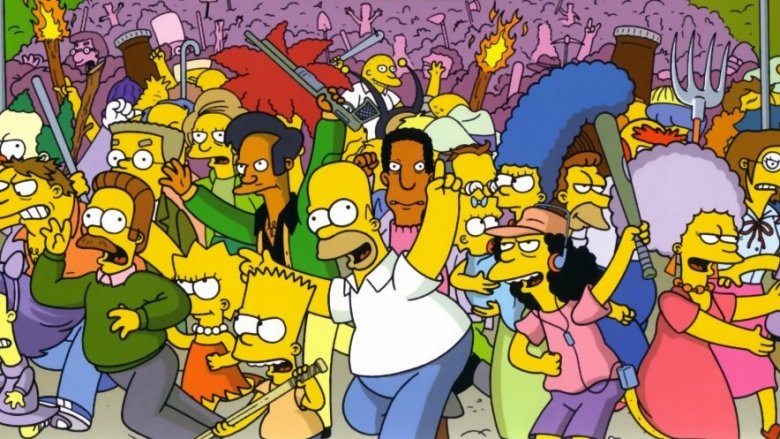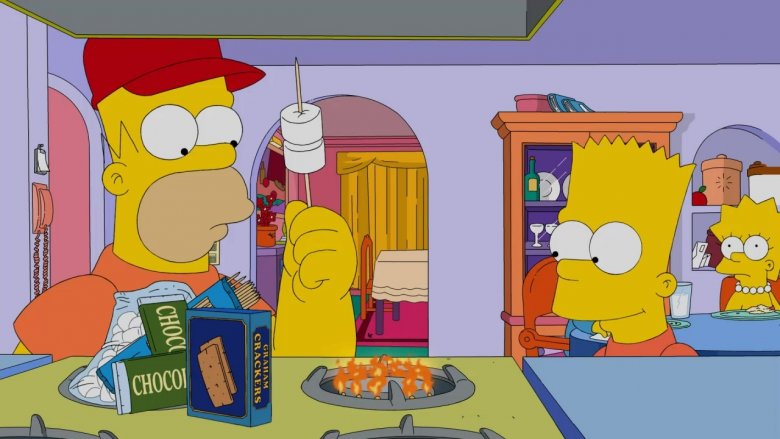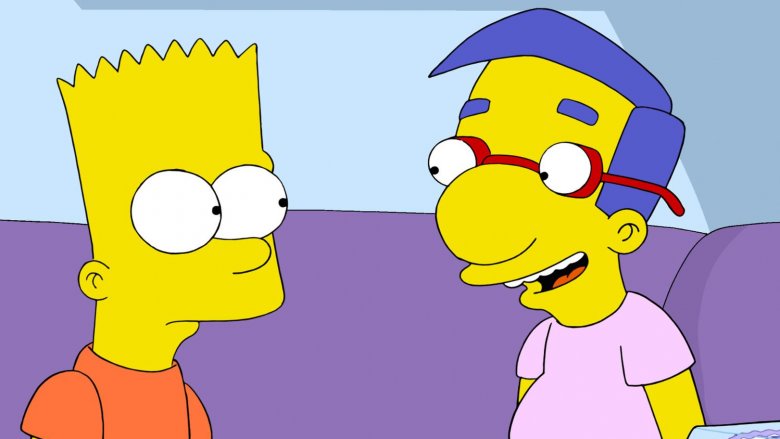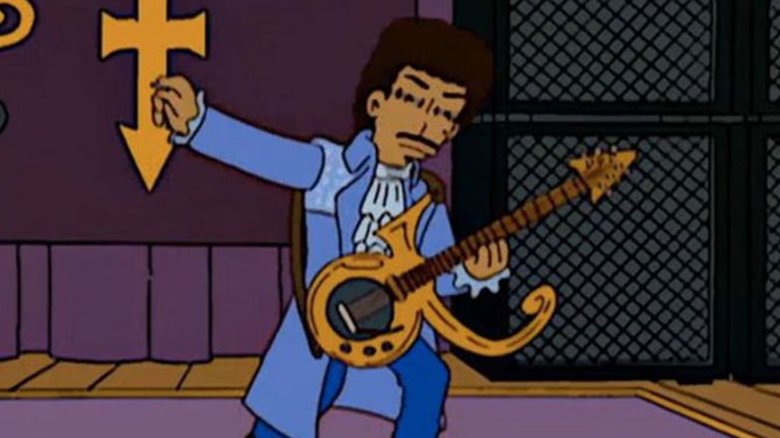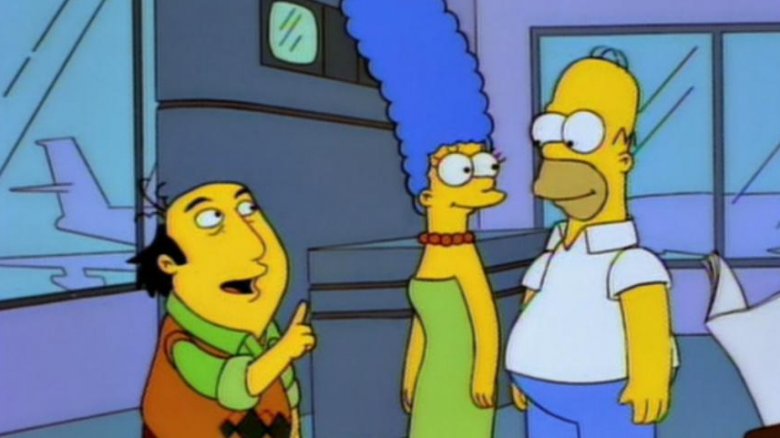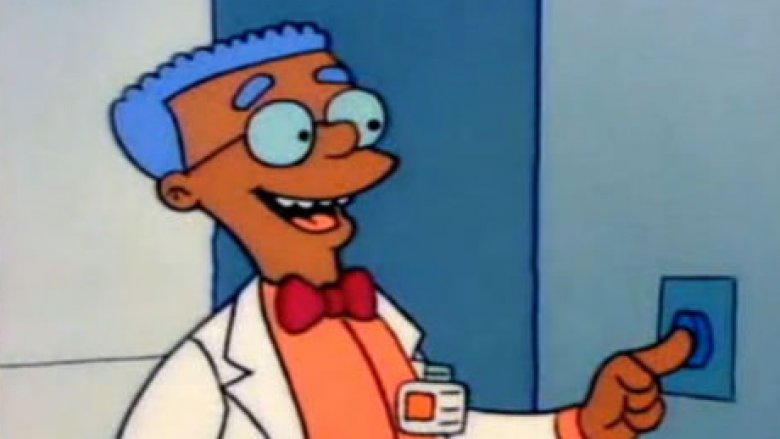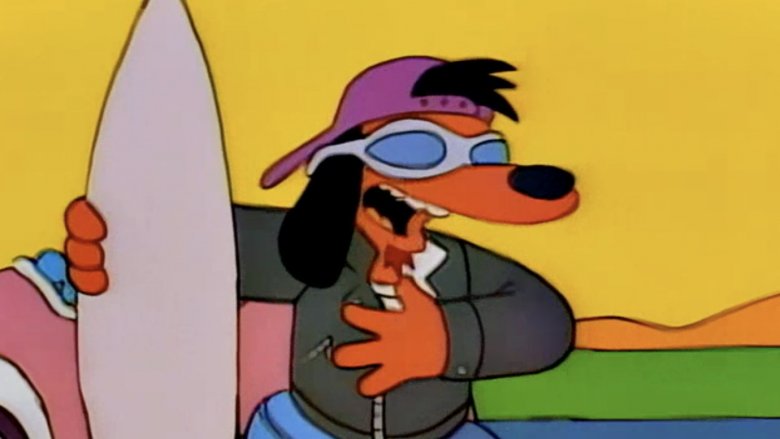The Untold Truth Of The Simpsons
Since its debut in 1989 (following a couple of years as short segments on Fox's The Tracey Ullman Show), The Simpsons has broadcast more than 600 episodes, been named among the all-time best programs by Vulture, Rolling Stone, and Time (among others), won more than two dozen Emmys and a Peabody Award, sold millions of dollars worth of merchandise, and generated hundreds of memorable characters—along with countless hilarious lines. It's a juggernaut of pop culture on the scale of the Beatles or Star Wars, which means that there's tons of lore and behind-the-scenes info about the world's favorite yellow-skinned family from Springfield.
Homer Simpson and Krusty the Clown were almost the same person
Bart Simpson has a palpable distrust for most adults, particularly Principal Skinner and his own father, whom he usually calls "Homer" instead of "Dad." About the only adult Bart respects is kiddie TV show host Krusty the Clown. This irony almost had another level to it. When Matt Groening and his writing staff were developing the show early on, someone floated the concept that Krusty and Homer were going to be one and the same. The joke was that Bart didn't recognize his dad under all the clown makeup and Homer, as Groening put it, "still couldn't get any respect from his son, who worshipped Krusty."
It became too complicated a plot detail to work out when the show was getting off the ground, so the idea was abandoned, but vestiges remain. For instance, Krusty and Homer have an almost identical character design—Krusty just has different hair and clown paint. Also, the sixth season episode "Homie the Clown" concerns Homer becoming a Krusty the Clown impersonator.
The Simpsons vs. the Bushes
The Simpsons' rivalry with President George H.W. Bush goes back a lot further than the neighbor dispute that erupts in the 1996 episode "Two Bad Neighbors." In a 1990 interview with People, then-First Lady Barbara Bush called the hot new show "the dumbest thing I had ever seen." In response, the show's writers sent Mrs. Bush a letter defending the show in the guise of Marge Simpson. "I recently read your criticism of my family. I was deeply hurt," Marge wrote. "Heaven knows we're far from perfect and, if truth be known, maybe just a wee bit short of normal; but as Dr. Seuss says, 'a person is a person.'"
Bush sent back a polite apology. But it wasn't over. Early in his 1992 re-election campaign, President Bush spoke to the Convention of the National Religious Broadcasters. "We are going to keep on trying to strengthen the American family, to make American families a lot more like the Waltons," vowed Bush, "and a lot less like the Simpsons." When an episode of The Simpsons aired shortly after, it included a clip of the Simpson family watching Bush's speech. Afterward, Bart quips, "Hey, we're just like the Waltons. We're praying for an end of the Depression, too."
It's a good thing they're animated
After spending years watching our favorite animated characters, they can almost start to seem real — but that doesn't mean you'd ever want to see them brought to life. Case in point: this 3D rendering of a lifelike Homer Simpson, which makes it painfully clear that everyone's favorite Springfield dad would be the stuff of nightmares if his distinctive features were ever anything more than a colorful cartoon. Posted in August of 2018, it's the work of 3D character artist Miguel Vasquez, whose previous work includes similarly disturbing versions of SpongeBob SquarePants characters as well as Phineas and Ferb. Check out his growing portfolio at Instagram and follow his updates on Twitter, but be warned — once you see these characters make the leap from safely 2D 'toons to three-dimensional nightmare fuel, they can never be unseen.
How Michael Jackson came to appear on the show
In the third season episode "Stark Raving Dad," Homer is mistakenly sent to a mental institution, where he's befriended by a hulking, balding, Caucasian patient named Leon who thinks he's Michael Jackson. He certainly had the voice of Michael Jackson—because the real King of Pop lent his vocal stylings to the episode. However, in the credits he was billed under the generic pseudonym "John Jay Smith."
So how did a brand-new TV series land the biggest pop star in the world? Jackson asked. First he phoned executive producer James L. Books and told him that he loved Bart, and that he wanted to be a part of the show. Jackson at first wanted to play himself, but relented when writers came up with the Leon idea.
Did Michael Jackson write Do the Bartman?
It's been long rumored that Michael Jackson wrote the Bart Simpson novelty song "Do the Bartman," the first single off the 1991 Simpsons album The Simpsons Sing the Blues. Perhaps it seemed like a legitimate fact, because it was none other than Simpsons creator Matt Groening who said at the 1998 World Animation Celebration that "it was always amazing to me that no one ever found out that Michael Jackson wrote that song."
In 2015, however, that notion was debunked by Bryan Loren, the musician and songwriter who's the credited writer of "Do the Bartman." Loren does say Jackson had a hand in the song—Jackson sings backing vocals, came up with the title, and suggested Loren include his name in the song. (Loren obliged. At one point, Bart quips, "If you can do the Bartman, you're bad like Michael Jackson.") Whoever wrote it, the song was a smash, hitting #11 on the American radio airplay chart and #1 in the U.K. Oddly enough, when Jackson asked James L. Brooks to be on the show, he promised to give Bart Simpson a number-one hit.
There were almost a couple of spinoffs
The Simpsons is one of the few successful, long-running TV shows to never generate a spinoff. But it's not for a lack of trying. In 1994, Matt Groening wrote a script for a new series that found Krusty the Clown getting his own talk show and moving to Los Angeles. But it wasn't going to be a cartoon—Groening wanted to do a live-action series, with Krusty's voice performer Dan Castellaneta reprising his role in the flesh. Groening changed it to an animated series because of one of the script's running gags. "Krusty was living in a house on stilts and there were beavers gnawing their way through the stilts," Groening said. "But somebody at the network pointed out how expensive it was to hire trained beavers—and an equally prohibitive cost would be to get mechanical beavers." Not even the animated version was produced, however, when negotiations between Groening and Fox broke down.
On the DVD commentary for the seventh season episode "22 Short Films About Springfield," Matt Groening discusses how the episode was nearly the impetus for a brand new Simpsons series. Like "22 Short Films," each episode of what was tentatively called Tales from Springfield would've consisted of a handful of short stories about minor Simpsons characters and Springfield residents. Ultimately, the show didn't have the manpower to produce two simultaneous TV series.
It reunited the Beatles
Apart from a couple of one-off singles in the '90s, the Beatles never reunited after their 1970 split—except on The Simpsons, albeit apart. At various points in the series' run, all three then-living Beatles (John Lennon died in 1980; George Harrison in 2001) appeared on the show.
In "Homer's Barbershop Quartet," the episode about Homer's brief period as a music superstar, he meets George Harrison at a party and is very excited...that the former Beatle has a brownie. Ringo Starr made an appearance when he finally got around to writing Marge a thank-you note for the portrait she painted of him decades prior. ("Dear Marge: Thanks for the fab painting of yours truly. I hung it on me wall!") Paul McCartney, and his wife and Wings bandmate Linda McCartney, encourage Lisa Simpson to adopt a vegetarian lifestyle like theirs in the 1995 episode "Lisa the Vegetarian." The McCartneys agreed to lend their voices on the condition that Lisa remain a vegetarian for the duration of the series—and she has.
In the same episode, Paul McCartney mentions that if you play his song "Maybe I'm Amazed" backward, one would hear a recipe for a "really ripping lentil soup." "Maybe I'm Amazed" plays over the episode's closing credits—complete with a backwards recording of a lentil soup recipe McCartney specially recorded.
Judd Apatow waited 25 years to write for the show
Today he's one of Hollywood's top comic screenwriters (The 40-Year-Old Virgin) and producers (Girls), but in 1990, Judd Apatow was 22 and trying to get a job writing for television. In the industry, the way to get your foot in the door is to write a "spec script." Writers pen a script for an existing TV show, and shop it around to demonstrate that they've got the chops and know the mechanics of the form. The Simpsons had only aired six episodes when Apatow wrote his Simpsons spec script, in which Homer is hypnotized, thinks he's 10 years old, and becomes close friends with Bart. Rarely if ever are these spec scripts actually made, but they've landed writers jobs. Apatow didn't get a job on The Simpsons, but before long he was working on The Ben Stiller Show and The Larry Sanders Show. More than 20 years later, Apatow discussed his spec script in interviews and in live appearances, which caught the attention of producer Al Jean, who put the script into production. The episode "Bart's New Friend" aired in January 2015.
The bizarre origins of Milhouse
In late 1988, when The Simpsons was still a feature on The Tracey Ullman Show and not yet its own series, producers made a deal to make a Butterfinger commercial featuring Bart Simpson. The script called for Bart to compare lunches with a friend at school, and so Simpsons staff filed through a series of drawings that Groening had done for an ultimately unproduced NBC Saturday morning cartoon set in a grade school. The one they picked to use as Bart's foil was an especially nerdy-looking kid who remained unnamed in the commercial, but he'd need one when he was absorbed into The Simpsons proper. Groening named him Milhouse because he "thought that was the most unfortunate name [he] could think of for a kid."
There's a lost episode featuring Prince
It's well known that late-night comedy icon Conan O'Brien was once a Simpsons writer. Among his contributions to the series: He wrote the classic episode "Marge vs. the Monorail." He also helped write a "lost episode" of The Simpsons that was supposed to star the late, great pop star Prince.
Set up as a sequel to the Simpsons episode "Stark Raving Dad," in which Homer met a mental patient named Leon who thinks he's Michael Jackson, Leon would return in "The Prince Episode," this time believing that he's Prince. Prince was all set to guest-voice as the new incarnation of Leon, but he backed out after the script had been written. Longtime Simpsons writer and producer Al Jean believes it's because Prince "didn't want to play second fiddle" to Michael Jackson. After Prince passed away in April 2016, Jean posted screen caps of the ultimately unproduced script to his Twitter page, which included a scene of Prince flirting with Marge's sister Selma after admitting she's seen Prince's box office bombs Under the Cherry Moon and Graffiti Bridge.
Matt Groening hated the 'Critic' crossover episode
Simpsons executive producer James L. Brooks was also an executive producer on The Critic, the short-lived, mid-'90s animated series that starred Jon Lovitz as TV film critic Jay Sherman, who hated most every movie he was forced to review. The show, created by long-time Simpsons writers and producers Al Jean and Mike Reiss, debuted on ABC in 1994, but after cancellation was picked up by Fox in 1995 thanks to some behind-the-scenes dealing by Brooks. Fox then gave it a great time slot, Sundays at 8:30, right after The Simpsons.
Brooks also arranged for a Critic crossover episode of The Simpsons in which Jay Sherman visits Springfield to judge a film festival. Groening, however, was adamantly opposed to the episode, thinking it amounted to little more than advertising. "The two reasons I am opposed to this crossover is that I don't want any credit or blame for The Critic and I feel this violates the Simpsons universe," Groening said. He even took his name off of the credits for the episode. Brooks called Groening's behavior "rotten." The episode took months to produce, but Groening waited until just before the episode aired to go on the offensive, hoping Brooks would change his mind at the last minute and pull the episode.
Smithers has changed a lot over the years
The third full-length Simpsons episode to air was the January 1990 entry "Homer's Odyssey." Making a brief appearance in the episode was Springfield Nuclear Power Plant boss Montgomery Burns' assistant Waylon Smithers. In that episode—and only in that episode—Smithers is depicted with dark brown skin. Thereafter, and to this day, Smithers has yellow skin. Why did he change? Creator Matt Groening says it was a production error. He was supposed to be yellow from the start, but the coloring artists mistakenly gave him a brown skin tone. There wasn't enough money in the budget to fix the error.
Also, for more than two decades of episodes, it was an open secret that Smithers was both a homosexual and deeply in love with Mr. Burns. Clues were present throughout the series, but it wasn't until an April 2016 episode when Smithers became openly gay (and also realized Mr. Burns would never return his affections). Staff writer Rob LaZebnik wrote the episode as a show of support for his son, Johnny, who is gay. "I am a Midwestern guy," he explained, "so I don't tend to wear my emotions on my sleeve, but I thought, 'What better way to tell my son I love him than to write a cartoon about it?'"
Fox wanted 'The Simpsons' to have its own Poochie
The eighth season episode "The Itchy & Scratchy & Poochie Show" parodied the once-common TV practice of shows bringing in a cooler, younger, or out-of-this-world character to freshen things up. (For example: Cousin Oliver on The Brady Bunch, or The Great Gazoo on The Flintstones.) On The Simpsons, it's Bart's beloved Itchy & Scratchy cartoons that add Poochie, a Homer-voiced, sunglasses-wearing, "rappin' surfer" who was "half Joe Camel and a third Fonzarelli." Poochie ends up being a total flop—viewers see through the cheap ratings ploy of the flashy new character. The premise is paralleled in the Simpsons household, which suddenly includes a never-before-seen, sunglasses-wearing college-age guy named Roy (who at the end of the episode moves out because he got an apartment with "two sexy ladies").
The episode so effectively satirized TV show attention-grabbing tactics because Fox had recently tried to do the same thing to The Simpsons. Before the eighth season began, Fox executives asked then-showrunners Bill Oakley and Josh Weinstein to add a new, fresh face to The Simpsons family. The writers gave them Roy and Poochie instead.
